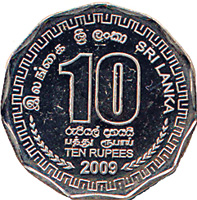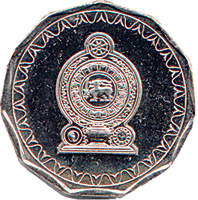
PREV ARTICLE
NEXT ARTICLE
FULL ISSUE
PREV FULL ISSUE
SRI LANKA REPLACING TEN-RUPEE BANKNOTE WITH COINS
Our man in Sri Lanka, Kavan Ratnatunga, published an article this week about that country's replacement of the ten rupee note with coins.
-Editor


On April 5, 2010, the Central Bank of Sri Lanka (CBSL), issued a new Rs. 10 coin to replace the Rs. 10 currency note that will be withdrawn gradually from circulation. The coin minted in nickel-plated steel is in the shape of a eleven-sided polygon. The obverse of the coin has the Armorial Ensign in the centre within a petal design along the periphery. The reverse has the face value of "10" in large numerals and in words in Sinhala, Tamil and English just below. They are flanked by ears of paddy on either side, above the year 2009, within a geometric design along the periphery. The coin has a mean weight of 8.36 grams which is slightly more than the old Rs. 2 coin. With a diameter of 26.4 mm it is just one millimetre larger than the old Rs. 1 coin. It has a thickness of 2.1mm which was selected to be in-between the Rs. 2 coin which is 1.7 mm and the Rs. 5 coin at 2.7 mm. This is to allow good resolution at coin vending machines. The 11-sided coin is like the Canadian dollar coin which is almost the same size at 26.5 mm but much lighter at 7 grams. By selecting a large odd number of sides it has a constant diameter and if rolled on a flat surface the centre of mass of the coin remains steady without wobbling up and down. The justification of using coins rather than currency notes is because coins last longer than currency notes which need to be withdrawn from circulation when they get worn out. However those like bus conductors who handle large amounts of small currency prefer currency notes since they can be folded horizontally and wrapped around their fingers. In 1940, just 70 years ago, 10 rupees was the value of a gold sovereign. The Sinhala term "Silima" for the British denomination shilling was 50 cents. With a gold sovereign now costing more than Rs. 30,000, it is ironic that at the time the 10-rupee coin is being introduced, its buying power is less than the half cent coin when it was demonetized in 1941. This being the case, one is surprised why the CBSL continues to mint 25 cent and 50 cent coins which are rarely seen in general circulation. The CBSL has a programme to collect coins from tills in major religious sites to keep them in circulation, but has little access to tills at homes. Bus fare and prices in shops no longer use fractional rupee value. It is clearly time that the CBSL made the rupee the lowest legal denomination. In many countries like Japan where the currency denomination is worth about a rupee, the fractional denominations have been abandoned. USA is debating whether to continue minting the one cent coin, and some European Union countries such as Finland and Netherlands produce them only for collector Mint sets. These are worth more than Rs. 1.
To read the complete article, see:
A new 10-rupee coin for your pocket: Is there sense in minting cents, asks Kavan Ratnatunga
(www.sundaytimes.lk/100411/Plus/plus_14.html)
The Numismatic Bibliomania Society is a non-profit organization promoting numismatic literature. See our web site at coinbooks.org. To submit items for publication in The E-Sylum, write to the Editor at this address: whomren@gmail.com To subscribe go to: https://my.binhost.com/lists/listinfo/esylum All Rights Reserved. NBS Home Page Contact the NBS webmaster 
|